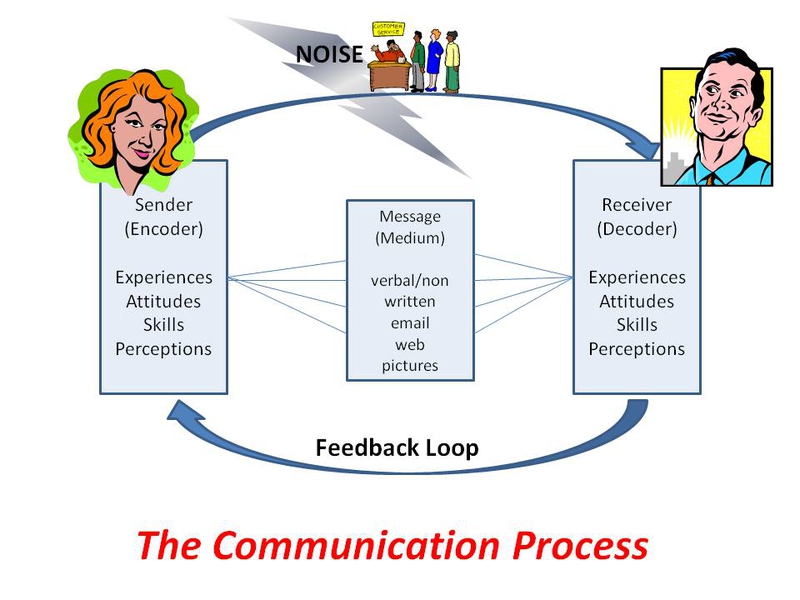The communication process is the way that we share our feelings, thoughts and ideas with other people and have them understand those feelings, thoughts and ideas. We communicate by listening, speaking and observing, but sometimes people find the process of communication difficult: it can be hard to let others become involved, making it important to understand how to create successful, natural communication. You may need to get a better understanding of the communication model and process before achieving effective communication. Below is a picture that helps you understand the process.

Communication Process and the Four Key Elements
Sender
The sender is the body who initiates the conversation, whether it is an organization, group, or individual. It is the sender who takes responsibility for the initial success of any message which will be influenced by the sender's cultural influences, perceptions, skills, knowledge, attitudes and experiences. When the sender send message, he will begin with the encoding process, which involves translating the information he wants to convey into a message made up of symbols representing concepts or ideas, which is then used for communication. The symbols can involve different types of communication, such as gestures, words or languages.
Channel
The sender uses a channel or medium to transmit the message as this is the method used to convey it. The majority of channels are written or oral, but the expansion of technology has led to an increase in the popularity of visual channels as well. The most common channels include the phone, reports, letters and memos with the effectiveness based on the communication’s characteristics.
Receiver
The person or group that the message is directed at is the receiver and they work to decode the sender’s messages. Their level of comprehension depends on their topic of the knowledge, the trust and relationship between them and the sender, and how receptive they are to the message. The receiver’s interpretation of the message is influenced by the culture, perceptions, skills, knowledge, attitudes and experiences, just like the factors that influence the sender’s encoding.
Feedback
The final step in the communication process is feedback and this is the receiver’s response to the message from the sender. It may be nonverbal or verbal and range from internal feedback like self-examination to external feedback that can actually be seen. The feedback gives the sender the necessary information so that they know whether they need to adjust their message to make it more effective. Feedback is essential to knowing whether the receiver understands the message correctly.
Video
The video below explain types of communication clearly and directly.
Barriers in Communication Process
Internal Barriers
An internal barrier is something that takes place involving one of the participants in the conversation. They can include emotions, lack of experiences in common, problems at home, a negative attitude, past experiences, mistrust, fear, a lack of interest, poor listening skills and fatigue.
External Barriers
External barriers are not controlled by the sender or receiver; instead they tend to be related to the surrounding environment. These may include the environment, the sender using terms that are too technical for the receiver, the time of day, a poor phone connection, non-functional e-mail, distractions and noise.
Successful and Effective Communication
Learn to Listen
Listening is a crucial part of effective communication. It involves doing more than just understanding the information and words; you must also work to understand how the sender feels about the topic. By listening effectively, you will create a stronger connection with the sender because they will feel understood and heard. You will also be able to create a safe environment so everyone feels comfortable to express their opinions, feelings and ideas. Effective listening also relieves negative emotions and saves time. To improve your listening ability, focus on the speaker completely, don’t interrupt them, avoid being judgmental and show you are interested.
Use Nonverbal Signals
Nonverbal signals are the one of the most important component of communicating topics that we are passionate about. These signals include body movement, gestures, posture, vocal tone, body movements, eye contact, breathing and muscle tension. Improve the effectiveness of the communication process by relying on open body language like having your arms uncrossed and being in an open stance. To improve nonverbal signal use, observe people, pay attention to differences between people and group interactions, rely on signals that match your words, and rely on body language to show positive feelings.
Minimize Stress
Stress can create a barrier to the communication process by interrupting your ability to act appropriately or think creatively and clearly. It also increases the chances of misreading someone. You don’t always have time to completely eliminate stress before communicating with someone, but you can minimize its effects by recognizing the signs, giving yourself a moment to relax, focusing on deep breaths or muscle contractions, finding humor, being willing to compromise, or simply agreeing to disagree.
Have Emotional Awareness
Being emotionally aware is a final key to effective communication as you may be unable to communicate your thoughts or feelings clearly if you aren’t aware of them yourself. That in turn leads to frustration, misunderstanding or even conflict. By being aware of your emotions, you can empathize with others, understand your goals, remain motivated, communicate effectively and clearly, and create relationships filled with strength and trust.

View All Comments /Add Comment